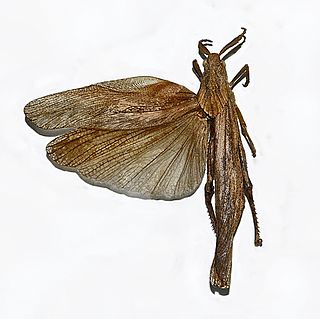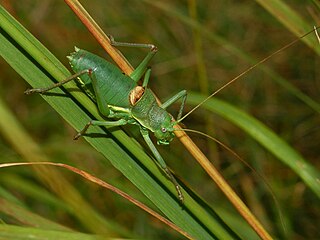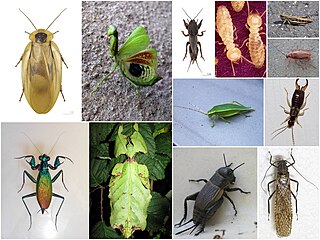
Calliptamus italicus, the Italian locust, is a species of 'short-horned grasshopper' belonging to the family Acrididae, subfamily Calliptaminae.

Miramella alpina, commonly known as the green mountain grasshopper, is a species of short-horned grasshopper in the family Acrididae.

Conocephalus fuscus, the long-winged conehead, is a member of the family Tettigoniidae, the bush-crickets and is distributed through much of Europe and temperate Asia. This bush-cricket is native to the British Isles where it may confused with the short-winged conehead. These two species are phenotypically similar; however, the distinguishing factor between the two is the fully developed set of wings the long-winged conehead possesses that allows for flight. In the short-winged coneheads the hind wings are shorter than the abdomen, causing the wings to be vestigial and the species is incapable of flight. For this reason it is hard to discriminate between the two species during the early stages of their life cycle before the wings have fully developed. The colouration of the conehead is typically a grass green with a distinctive brown stripe down its back, though there are some brown phenotypes.

Barbitistes obtusus, the southern saw-tailed bush-cricket or Alpine saw bush-cricket, is a species of bush crickets in the subfamily Phaneropterinae.

Stenobothrus rubicundulus, the wing-buzzing grasshopper, is a species of short-horned grasshoppers in the family Acrididae.

Phymateus aegrotus, sometimes called the blue bush locust or East African bush locust, is a pest species of grasshopper in the family Pyrgomorphidae. Unlike "locusts" the adults are not known to change their morphology on crowding, but at the hopper stage, marching behaviour of small bands may occur.

Xiphoceriana atrox is a species of grasshoppers belonging to the family Pamphagidae.

Calephorus compressicornis is a species of grasshopper in the tribe Calephorini found in Europe and Africa.

Leptophyes laticauda is a species of bush-crickets belonging to the family Tettigoniidae.

Locusta migratoria cinerascens is a subspecies of the migratory locust in the family Acrididae.

Ephippiger perforatus, the North Apennine saddle bush-cricket, is a species of insect in the family Tettigoniidae.

The cohort Polyneoptera is one of the major groups of winged insects, comprising the Orthoptera and all other neopteran insects believed to be more closely related to Orthoptera than to any other insect orders. They were formerly grouped together with the Palaeoptera and Paraneoptera as the Hemimetabola or Exopterygota on the grounds that they have no metamorphosis, the wings gradually developing externally throughout the nymphal stages. Many members of the group have leathery forewings (tegmina) and hindwings with an enlarged anal field (vannus).

Calliptamus is a genus of grasshoppers in the family Acrididae. Species of Calliptamus are found in Africa and the northern Palearctic realm through to Japan.

Schistocerca damnifica, known generally as the mischievous bird grasshopper or Carolina locust, is a species of bird grasshopper in the family Acrididae. It is found in North America.
P. S. Nathan, P. Susai Nathan or P. Susainathan was an Indian naturalist, entomologist and a natural history specimen collector and dealer. His natural history business was continued by his daughter-in-law Theresa Rajabai Susai Nathan and still later by her daughter-in-law Nellie J.P. Nathan. A number of species are named after the collections made by him and his family.

Howard Radclyffe Roberts Jr. was an American entomologist known for his work on grasshoppers. His 1941 University of Pennsylvania Ph.D. dissertation was an early work highlighting the role phallic structures could play in grasshopper taxonomy. While serving in World War II, he and Edward Shearman Ross cowrote The Mosquito Atlas, used by the armed forces to identify malaria-transmitting mosquitos. Roberts worked for the Academy of Natural Sciences of Philadelphia (ANSP), serving as its managing director from 1947 to 1972. He described dozens of grasshopper species from North and South America, and also is the eponym of several taxa named in his honor.

Josef Redtenbacher was an Austrian entomologist and teacher. He specialized in the orders of Orthoptera, Phasmatodea, Mantodea (mantis) and Blattodea (cockroaches), which are classically summarized as Orthoptera, as well as in the earwigs (Dermaptera), which are not assigned to the Orthoptera, especially from Austria-Hungary and Germany.
Eremippus is a genus of Palaearctic grasshoppers in the tribe Dociostaurini, erected by Boris Uvarov in 1926. Species are recorded from eastern Europe and central Asia through to eastern China.
Tisamenus asper is a stick insect species (Phasmatodea), in the family of the Heteropterygidae endemic to the Philippine island Luzon.
Valanga chloropus is a species of grasshopper native to Java. It was scientifically described in 1932 by Sjöstedt.

















